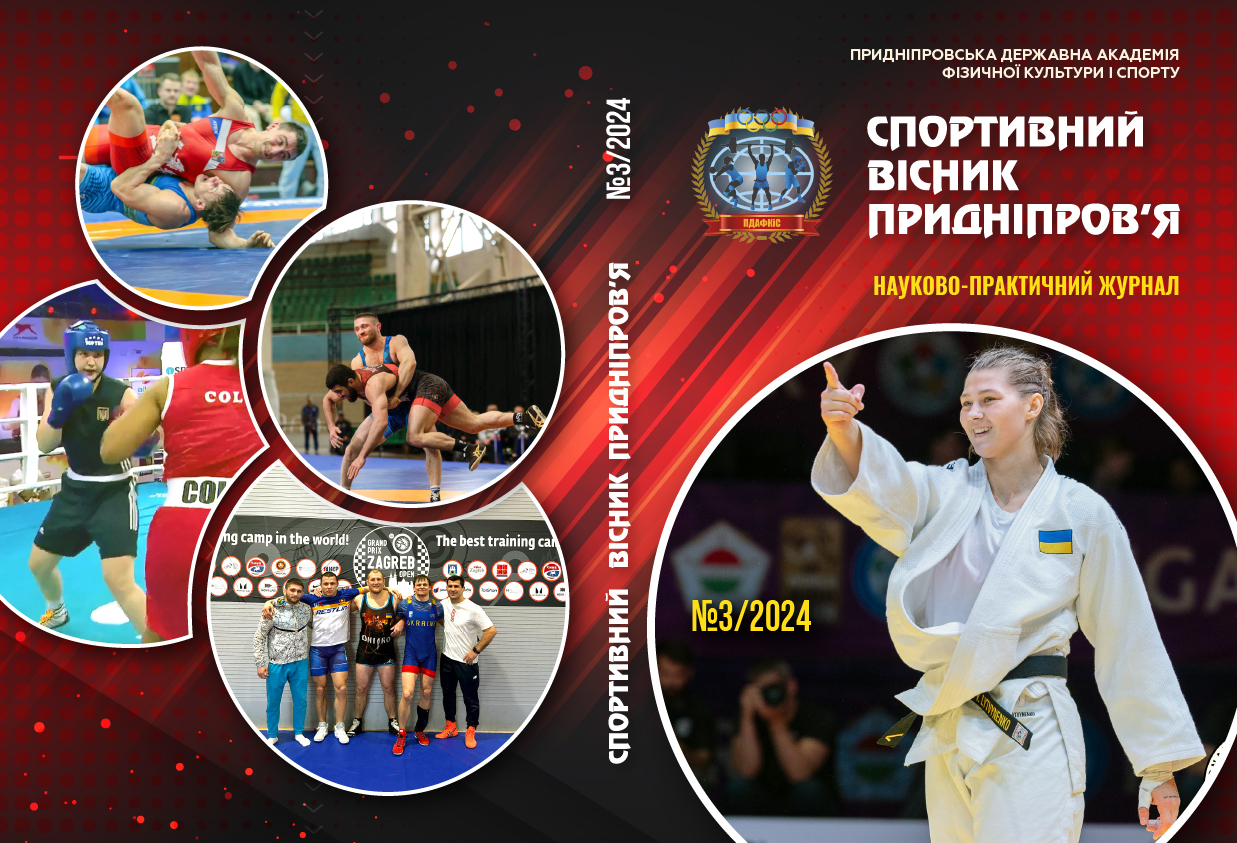Neurodynamic properties of attacking players in team sports
DOI:
https://doi.org/10.32540/2071-1476-2024-3-154Keywords:
neurodynamic properties, forward players, sport gamesAbstract
Introduction. Scientists indicate that neurodynamic functions, which include innate individual-typological properties of the higher departments of the central nervous system and sensorimotor reactions of varying degrees of complexity, have a direct impact on the success of human activity in many areas of life, including sports. The main function of forward players in sport games is to effectively complete the attacking actions of their own team. An interesting question is whether there can be differences in the manifestations of neurodynamic functions of forward players specializing in different sport games. The goal of the research is to find out the peculiarities of the manifestation of neurodynamic properties of for-ward players specializing in various types of sport games. Materials and Methods. The individual and typological properties of nervous processes and sensorimotor re-actions of various degrees of complexity were determined in forward players of professional sport game teams (volleyball, basketball, football, field hockey and ice hockey) using the ‘Diagnost-1M’ computer system. Research Results. Differences in the indicators of sensorimotor reactions of various degrees of complexity and individual typological properties of higher nervous activity were established analyzing the results of the manifestation of neurodynamic functions in forward players, representatives of various sport games. Forward basketball and volleyball players were characterized by the best indicators. Significant differences (p<0.05) were established according to the study results on the manifestation of neurodynamic functions among sportsmen, representatives of various sport games. Conclusions. Data on the peculiarities of the manifestation of neurodynamic properties of forward players, representatives of various sports may indicate a dependence on the specifics of competitive activity inherent in various types of sport games.
References
Vozniuk TV. Modern sport games: a study guide. Vinnytsia: DOV “Vinnytsia”; 2008. 350 p
Lysenchuk HA, Solomonko VV, Solomonko OV. Football. K.: Olympic literature; 2007. 288 p
Rovnyi AS, Lyzohub VS. Psychosensory mechanisms of movement control of sportsmen. Kharkiv: KhNAHU; 2016. 359 p
Platonov VN. Motor qualities and physical training of sportsmen. Kyiv: Olympic Literature; 2017. 656 p
Kostiukevych VM. Theoretical and methodical bases of modelling the training process of sport game sportsmen: Dissertation abstract for obtaining the scientific degree of Doctor of Sciences in Physical Education and Sport: Speciality. “Olympic and Professional Sports”. Kyiv: 2012. 41 p
Kozyna ZhL. Individualization of sportsmen’s training in sport games. Kharkiv: 2009. 396 p
Mitova O. Technology of implementing control system in team sport games in the process of long-term improvement. Physical culture, sport and health of the nation. 2020;10(29):83-91
Minhaliov OH, Drehval IV. Analysis of the functional state of the sensorimotor reaction and the main nervous processes of sport game sportsmen. Bulletin of problems of biology and medicine. 2017; (4):268-70
Korobeinikov H, Prystupa Ye, Korobeinikova L, Briskyn Yu. Evaluation of psychophysiological states in sportsmen. Lviv: LSUPC; 2013. 312 p
Mishchenko VS. Psychophysiological state of highly qualified sportsmen with different levels of neurodynamic functions. Bulletin of Cherkasy University. 2017(2):45-53
Hlazyrin ID, Artemenko BO. Relationship of psychophysiological and neurodynamic functions with technical and tactical preparation of volleyball players. Pedagogy, psychology and medical-biological problems of physical education and sports. 2013;(6):25-9
Artemenko BO. Connection of functional mobility of nervous processes with the success of game activities of highly qualified volleyball players. Bulletin of Cherkasy University. 2018;(2):15-9
Makarenko MV, Lyzohub VS. Ontogeny of human psychophysiological functions. Cherkasy: Vertical; 2011. 255 p.
Lyzohub VS, Nechyporenko LA, Pustovalov VO, Shpaniuk VV, Haliavka RM. Neurodynamic properties of football players of different playing roles. Sportyvnyi Visnyk Prydniprovia. 2019;(4):58-63. https://doi.org/10.32540/2071-1476-2019-4-058
Lyzohub V, Pustovalov V, Nechyporenko L, Hrechukha S, Bezkopylnyi O, Grebiniuk N. Characteristics of neurodynamic properties of goalkeepers in sport games. Sportyvnyi Visnyk Prydniprovia. 2022.(3):165-72. https://doi.org/10.32540/2071-1476-2022-3-165
Lyzohub VS, Pustovalov VO, Nechyporenko LA, Haliavka RM, Grebiniuk NM. Neurodynamic properties of defensive players of various sport games. Sportyvnyi Visnyk Prydniprovia. 2023;(2):121-27. https://doi.org/10.32540/2071-1476-2023-2-121
Lyzohub VS, Shpaniuk VV, Pustovalov VO, Kozhemiako TV, Suprunovych VO. Do the results of sensorimotor response reflect the typological properties of the central nervous system? Bulletin of Cherkasy University. Biological Sciences Series. 2021;(1):69-77. https://bio-ejournal.cdu.edu.ua/article/view/4252/0
Korobeinikov HV. Formation of the structure of psychophysiological characteristics of volleyball players of various roles. Young sports science of Ukraine. 2015;(1):103-8.
Lyzohub VS, Pustovalov VO, Suprunovych VO, Hrechukha SV. Neurodynamic functions of basketball players of different game roles. Sportyvnyi Visnyk Prydniprovia. 2016;(3):241-5
Lyzohub VS, Pustovalov VO, Suprunovych VO, Hrechukha SV. Modern approaches to the implementation of the selection of highly qualified football players based on indicators of neurodynamic properties of the higher departments of the central nervous system. Slobozhansky Scientific and Sports Bulletin. 2017;(2):81-5
Downloads
Published
How to Cite
Issue
Section
License

This work is licensed under a Creative Commons Attribution 4.0 International License.
Authors retain copyright of the published papers and grant to the publisher the non-exclusive right to publish the article, to be cited as its original publisher in case of reuse, and to distribute it in all forms and media. Articles will be distributed under the Creative Commons Attribution 4.0 International (CC BY 4.0) licence.
Authors can enter the separate, additional contractual arrangements for non-exclusive distribution of the published paper (e.g., post it to an institutional repository or publish it in a book), with an acknowledgement of its initial publication in this journal.

